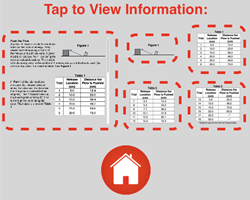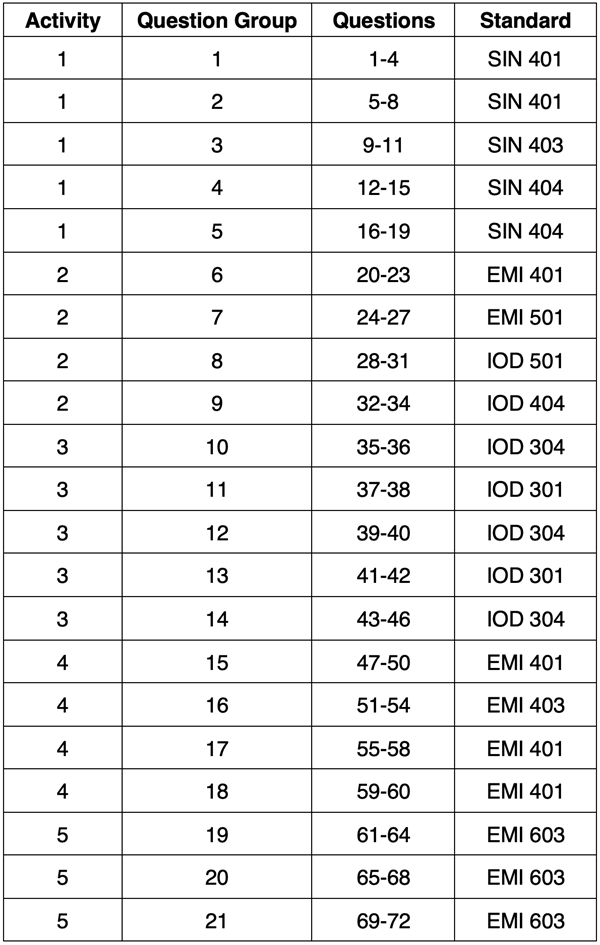About the Science Reasoning Center
 Highly Recommended
Highly RecommendedLike all our Science Reasoning Center activities, the completion of the Push the Plow activity requires that a student use provided information about a phenomenon, experiment, or data presentation to answer questions. This information is accessible by tapping on the small thumbnails found on the bottom right of every question. However, it may be considerably easier to have a printed copy of this information or to display the information in a separate browser window. You can access this information from this page.
The Standards
The Push the Plow describes a set of three experiments in which a marble rolls down an incline, collides with a note card (the plow), and pushes the note card across a level surface until it stops. This five-part activity addresses student's ability to understand the design of an experiement, to identify evidence-based claims, to use proportional reasoning skills to determine relationships between variables, and to predict the result of additional trials. Success with the activity requires some degree of proficiency with respect to ...
- Asking Questions and Defining Problems (Science and Engineering Practice 1.3)
Ask questions to determine relationships, including quantitative relationships, between independent and dependent variables. - Developing and Using Models (Science and Engineering Practice 2.3)
Develop, revise, and/or use a model based on evidence to illustrate and/or predict the relationships between systems or between components of a system. - Planning and Carrying Out Investigations (Science and Engineering Practice 3.5)
Make directional hypotheses that specify what happens to a dependent variable when an independent variable is manipulated. - Analyzing and Interpreting Data (Science and Engineering Practice 4.1)
Analyze data using tools, technologies, and/or models (e.g., computational, mathematical) in order to make valid and reliable scientific claims or determine an optimal design solution. - Constructing Explanations and Designing Solutions (Science and Engineering Practice 6.4)
Apply scientific reasoning, theory, and/or models to link evidence to the claims to assess the extent to which the reasoning and data support the explanation or conclusion. - Patterns (Crosscutting Concept 1.2)
Empirical evidence is needed to identify patterns. - Cause and Effect (Crosscutting Concept 2.2)
Systems can be designed to cause a desired effect. - Scale, Proportion, and Quantity (Crosscutting Concept 3.2)
Algebraic thinking is used to examine scientific data and predict the effect of a change in one variable on another (e.g., linear growth vs. exponential growth).
While the Push the Plow activity addresses the three NextGen Science and Engineering Practices and the two crosscutting concepts above, the activity drew its greatest inspiration from ACT's College Readiness Standards for Science Reasoning. The activity consists of 72 questions organized into 21 Question Groups that are spread across the five activities. All three strands (Interpretation of Data - IOD; Science Investigation - SIN; and Evaluation of Models, Inferences, and Experimental Results - EMI) of the College Readiness Standards are addressed in this activity. The code given for the standard includes three letters to indicate the strand and three numbers to indicate the specific standard within that strand. Higher numbers are indicative of more complex science reasoning skills. The relationship between the questions and the standards is as follows:

Complementary and Similar Resources
The following resources at The Physics Classroom website complement the Push the Plow Science Reasoning Activity. Teachers may find them useful for supporting students and/or as components of lesson plans and unit plans.
The Physics Classroom Tutorial, Work, Energy and Power Chapter
Physics Video Tutorial, Work, Energy, and Power: Mechanical Energy Conservation
Physics Video Tutorial, Work, Energy, and Power: Force and System Analysis
Physics Interactives, Work and Energy: Roller Coaster Model
Physics Interactives, Work and Energy: Chart That Motion
Concept Builders, Work and Energy: What's Up and Down with KE and PE?
Concept Builders, Work and Energy: Words and Charts
Concept Builders, Work and Energy: LOL Charts
Concept Builders, Work and Energy: Energy Analysis 1
Minds On Physics, Work and Energy Module: Mission WE6, Energy Bar Charts
Minds On Physics, Work and Energy Module: Mission WE8, Energy Analysis
The Calculator Pad, Work, Energy, and Power: Problem Sets WE6 - WE14
Recommended: Print Passage, Tables, and Graphs
Also see: